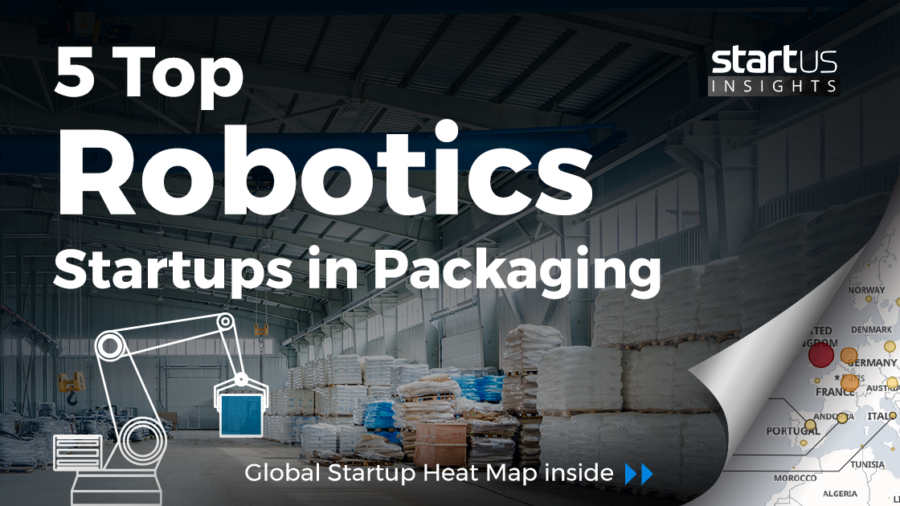
Heat Map: 5 Top Robotics Startups For our 5 top picks, we used a data-driven startup scouting approach to identify the most relevant solutions globally. The Global Startup Heat Map below highlights 5 interesting examples out of 214 relevant solutions. Depending on your specific needs, your top picks might look entirely different. PackIt Systems – Robotic Bagging Manual bagging requires a lot of labor and is prone to human error which increases the inconsistencies in product quality. It is also time-consuming and difficult to set standards for. Robotic bagging systems offer solutions to these issues. Besides, automated bagging also improves worker safety in hazardous industries like chemicals and pharmaceuticals. Indian startup PackIt Systems offers automated bagging solutions that can be applied to many diverse industries. Their system is compact and designed for ergonomic loading. In addition, it can automatically label the bagged items. It offers bag sizes from 200mm to 500mm in width and 350mm to 700mm in length. Unisorting – Robotic Packing Traditional packing methods currently use a mix of manual and semi-automatic solutions to pack the items. Packers simply do not invest in machinery as they are able to find labor, which works well for them in the short-term. However, packing has slowly begun using robotic arms and automated systems to efficiently pack items. This reduces the labor headcount required and improves the productivity of packing. Italian startup Unisorting, a recent merger between three Italian food and technology companies, develops a complete suite of solutions for processing fruits and vegetables aiming to reduce packing costs. Their automatic packing system can group, pick, and pack the items into the necessary packages. They also offer semi-automatic packing solutions. IAMRobotics – Robotic Picking The entire packaging process requires items to be moved around the floor. Items are being moved from before packaging can begin up to the final loading area. While large companies can employ labor or invest in technology, smaller companies are usually left to rely on limited labor for their operations. Robotic picking can greatly improve the productivity of picking and moving items while cutting on high labor costs. The US-based startup IAMRobotics develops the Swift Robot, an autonomous mobile manipulation robot designed for material handling. It navigates multiple aisles to move using machine vision technology for the robots to see and locate objects in 3D and in real-time. Swift is capable of picking and transporting products at human-level speeds, which enables packers to scale operations more cost-effectively. Robot Systems – Robotic Palletizing / Depalletizing Packaging usually depends on the standards for logistics and transportation. Shipping containers come in standard sizes, which are designed based on truck capacities. All these logistic issues mean packaging companies have to arrange their products, by palletizing, so that it becomes easy to load them onto trucks, and subsequently onto planes or ships. Moreover, manually palletizing items can be labor-intensive with a risk of stress and injury. The US-based startup Robot Systems develop robotic palletizing and depalletizing systems. Utilizing articulating robot arms allows for flexibility and versatility. Using automatic tool changers, the robot can switch between palletizing bags, cartons, pouches, kegs, barrels, and drums. Depending on the throughput rates, the robot can also perform other tasks such as sheet placement, pallet placement, or even labeling of containers. Kindred AI – Robotic Sorting Companies dealing with small items or quantities may sometimes produce them and later sort them for packaging. This process becomes tedious to do manually and could result in poor end consumer experiences. Robotic sorting systems will help keep the packages moving to the correct piles for secondary packaging. Such systems can easily be scaled without really increasing the headcount. The US-based startup Kindred AI develops SORT, a robotic sorting and piling system. Equipped with reinforcement learning and proprietary grasping technology, the robot can identify items, differentiate between end piles, and move the items there. Their systems automate repetitive tasks, thus improving the conditions for workers. What About The Other 209 Solutions? While we believe data is key to creating insights it can be easy to be overwhelmed by it. Our ambition is to create a comprehensive overview and provide actionable innovation intelligence for your Proof of Concept (PoC), partnership, or investment targets. The 5 startups showcased above are promising examples out of 214 we analyzed for this article. To identify the most relevant solutions based on your specific criteria and collaboration strategy, get in touch.







